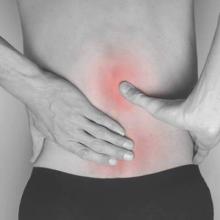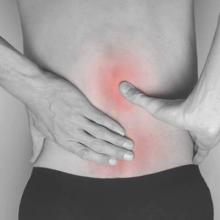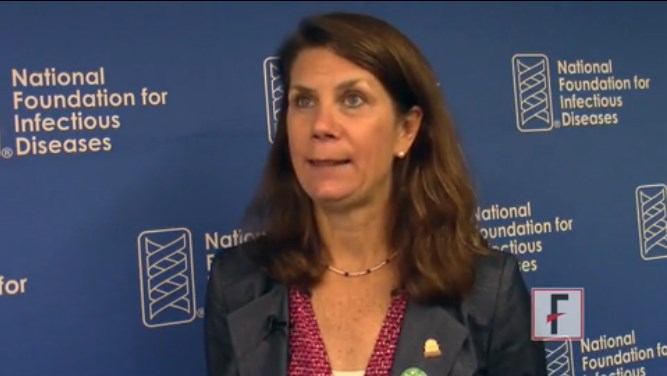User login
Study: Disproportionately high HIV infection rate for Hispanics
Hispanics or Latinos in the United States make up a disproportionately high percentage of individuals with human immunodeficiency virus (HIV) infections, according to a recent study in the Morbidity and Mortality Weekly Report published by the Centers for Disease Control and Prevention.
According to data from the CDC’s National HIV Surveillance System, Hispanics or Latinos accounted for 57,406 (20.8%) of the 276,633 adult and adolescent HIV infections diagnosed between 2008 and 2013, despite overall rates of infection among Latinos or Hispanics being lower over that timeframe than during previous years. However, the study (MMWR. 2015 Oct 9;64[39]:1097-103) found an increase in the number of Latinos or Hispanics diagnosed with HIV infection as a result of male-to-male sexual contact, rising from 6,141 in 2008 to 7,098 in 2013 – an increase of 16%.
“Hispanics or Latinos represent about 17% of the total U.S. population [but] in 2013, the rate of HIV diagnosis among Hispanics or Latinos (18.7%) was nearly three times that of non-Hispanic whites (6.6%),” said Kristen Mahle Gray of the CDC’s division of HIV/AIDS prevention, and her coauthors.
The research team also collected data on means of HIV transmission and place of birth, which revealed that 82.8% of Hispanic or Latino men diagnosed with HIV in 2013 were infected via male-to-male contact, while 87.2% of women were infected via heterosexual intercourse. The rate of persons living with HIV infection among Hispanics or Latinos was estimated at 458.8/100,000 population, and the estimated HIV prevalence ranged from 73.6/100,000 population in Montana to 1,947.5/100,000 in the District of Columbia.
Injection drug use was found as the cause of HIV transmission for 24.9% of males born in Puerto Rico, significantly higher than the rates for those born in Central America (4.5%), Cuba (2.5%), Mexico (4.7%), and South America (2.1%). Similarly, Hispanic or Latino females born in either the United States or Puerto Rico had a higher proportion of HIV infections resulting from injection drug use than those born elsewhere – 21.2% and 20.5%, respectively.
“The higher rate of HIV infection among Hispanics or Latinos indicates that much work still needs to be done to reach Hispanics or Latinos at high risk for acquiring or transmitting HIV infection,” the report concludes. “Targeted strategies for Hispanic or Latino subpopulations, such as men who have sex with men and persons who inject drugs, present prevention challenges and warrant expanded efforts.”
Hispanics or Latinos in the United States make up a disproportionately high percentage of individuals with human immunodeficiency virus (HIV) infections, according to a recent study in the Morbidity and Mortality Weekly Report published by the Centers for Disease Control and Prevention.
According to data from the CDC’s National HIV Surveillance System, Hispanics or Latinos accounted for 57,406 (20.8%) of the 276,633 adult and adolescent HIV infections diagnosed between 2008 and 2013, despite overall rates of infection among Latinos or Hispanics being lower over that timeframe than during previous years. However, the study (MMWR. 2015 Oct 9;64[39]:1097-103) found an increase in the number of Latinos or Hispanics diagnosed with HIV infection as a result of male-to-male sexual contact, rising from 6,141 in 2008 to 7,098 in 2013 – an increase of 16%.
“Hispanics or Latinos represent about 17% of the total U.S. population [but] in 2013, the rate of HIV diagnosis among Hispanics or Latinos (18.7%) was nearly three times that of non-Hispanic whites (6.6%),” said Kristen Mahle Gray of the CDC’s division of HIV/AIDS prevention, and her coauthors.
The research team also collected data on means of HIV transmission and place of birth, which revealed that 82.8% of Hispanic or Latino men diagnosed with HIV in 2013 were infected via male-to-male contact, while 87.2% of women were infected via heterosexual intercourse. The rate of persons living with HIV infection among Hispanics or Latinos was estimated at 458.8/100,000 population, and the estimated HIV prevalence ranged from 73.6/100,000 population in Montana to 1,947.5/100,000 in the District of Columbia.
Injection drug use was found as the cause of HIV transmission for 24.9% of males born in Puerto Rico, significantly higher than the rates for those born in Central America (4.5%), Cuba (2.5%), Mexico (4.7%), and South America (2.1%). Similarly, Hispanic or Latino females born in either the United States or Puerto Rico had a higher proportion of HIV infections resulting from injection drug use than those born elsewhere – 21.2% and 20.5%, respectively.
“The higher rate of HIV infection among Hispanics or Latinos indicates that much work still needs to be done to reach Hispanics or Latinos at high risk for acquiring or transmitting HIV infection,” the report concludes. “Targeted strategies for Hispanic or Latino subpopulations, such as men who have sex with men and persons who inject drugs, present prevention challenges and warrant expanded efforts.”
Hispanics or Latinos in the United States make up a disproportionately high percentage of individuals with human immunodeficiency virus (HIV) infections, according to a recent study in the Morbidity and Mortality Weekly Report published by the Centers for Disease Control and Prevention.
According to data from the CDC’s National HIV Surveillance System, Hispanics or Latinos accounted for 57,406 (20.8%) of the 276,633 adult and adolescent HIV infections diagnosed between 2008 and 2013, despite overall rates of infection among Latinos or Hispanics being lower over that timeframe than during previous years. However, the study (MMWR. 2015 Oct 9;64[39]:1097-103) found an increase in the number of Latinos or Hispanics diagnosed with HIV infection as a result of male-to-male sexual contact, rising from 6,141 in 2008 to 7,098 in 2013 – an increase of 16%.
“Hispanics or Latinos represent about 17% of the total U.S. population [but] in 2013, the rate of HIV diagnosis among Hispanics or Latinos (18.7%) was nearly three times that of non-Hispanic whites (6.6%),” said Kristen Mahle Gray of the CDC’s division of HIV/AIDS prevention, and her coauthors.
The research team also collected data on means of HIV transmission and place of birth, which revealed that 82.8% of Hispanic or Latino men diagnosed with HIV in 2013 were infected via male-to-male contact, while 87.2% of women were infected via heterosexual intercourse. The rate of persons living with HIV infection among Hispanics or Latinos was estimated at 458.8/100,000 population, and the estimated HIV prevalence ranged from 73.6/100,000 population in Montana to 1,947.5/100,000 in the District of Columbia.
Injection drug use was found as the cause of HIV transmission for 24.9% of males born in Puerto Rico, significantly higher than the rates for those born in Central America (4.5%), Cuba (2.5%), Mexico (4.7%), and South America (2.1%). Similarly, Hispanic or Latino females born in either the United States or Puerto Rico had a higher proportion of HIV infections resulting from injection drug use than those born elsewhere – 21.2% and 20.5%, respectively.
“The higher rate of HIV infection among Hispanics or Latinos indicates that much work still needs to be done to reach Hispanics or Latinos at high risk for acquiring or transmitting HIV infection,” the report concludes. “Targeted strategies for Hispanic or Latino subpopulations, such as men who have sex with men and persons who inject drugs, present prevention challenges and warrant expanded efforts.”
FROM MMWR
Ebola virus may persist in semen 9 months after symptom onset
Male survivors of Ebola virus disease (EVD) may still have the virus present in their semen as long as 9 months after the onset of symptoms, according to a new study published in the New England Journal of Medicine.
The study – led by Dr. Gibrilla Deen of Connaught Hospital in Freetown, Sierra Leone – enrolled 100 male survivors of EVD in Sierra Leone, of whom 93 provided a semen specimen at some time after the onset of symptoms, which was analyzed for Ebola virus RNA. Specimens were analyzed via a reverse-transcriptase polymerase chain reaction assay.
Results indicated that 46 of the 93 men (49%) who provided the initial semen sample tested positive for Ebola virus RNA. All 9 (100%) of the men whose specimens were analyzed 2-3 months after the onset of symptoms tested positive. Of the 40 whose specimens were received 4-6 months after symptom onset, 26 (65%) tested positive. Eleven of the 43 (26%) whose specimens were obtained 7-9 months after symptom onset were positive, as well.
“Ebola survivors face an increasing number of recognized health complications,” said Dr. Tom Frieden, director of the Centers for Disease Control and Prevention, in a statement, adding that “this study provides important new information about the persistence of Ebola virus in semen and helps us make recommendations to survivors and their loved ones to help them stay healthy.”
All participants were aged 18-58 years, with a mean of 30 years. While 63% of subjects had at least 6 years of formal education, 22% had less than that, and 15% had no formal education of any kind. Only 10% of subjects reported a monthly income of moe than $1,000, while 43% reported not knowing their income at all. None of the participants reported a history of HIV, tuberculosis, or diabetes diagnoses.
“Because semen-testing programs are not yet universally available, outreach activities are needed to provide education regarding recommendations and risks to survivor communities and sexual partners of survivors in a way that does not further stigmatize [the] survivors of EVD,” according to the study.
The authors of the study acknowledge that their findings are potentially limited by the size of their sample, as well as the lack of data on the risk of trasmission via sexual intercourse or other sex acts from men with Ebola virus RNA in their semen. Follow-up analysis of the current findings is underway.
Dr. Deen did not report any relevant financial disclosures.
Male survivors of Ebola virus disease (EVD) may still have the virus present in their semen as long as 9 months after the onset of symptoms, according to a new study published in the New England Journal of Medicine.
The study – led by Dr. Gibrilla Deen of Connaught Hospital in Freetown, Sierra Leone – enrolled 100 male survivors of EVD in Sierra Leone, of whom 93 provided a semen specimen at some time after the onset of symptoms, which was analyzed for Ebola virus RNA. Specimens were analyzed via a reverse-transcriptase polymerase chain reaction assay.
Results indicated that 46 of the 93 men (49%) who provided the initial semen sample tested positive for Ebola virus RNA. All 9 (100%) of the men whose specimens were analyzed 2-3 months after the onset of symptoms tested positive. Of the 40 whose specimens were received 4-6 months after symptom onset, 26 (65%) tested positive. Eleven of the 43 (26%) whose specimens were obtained 7-9 months after symptom onset were positive, as well.
“Ebola survivors face an increasing number of recognized health complications,” said Dr. Tom Frieden, director of the Centers for Disease Control and Prevention, in a statement, adding that “this study provides important new information about the persistence of Ebola virus in semen and helps us make recommendations to survivors and their loved ones to help them stay healthy.”
All participants were aged 18-58 years, with a mean of 30 years. While 63% of subjects had at least 6 years of formal education, 22% had less than that, and 15% had no formal education of any kind. Only 10% of subjects reported a monthly income of moe than $1,000, while 43% reported not knowing their income at all. None of the participants reported a history of HIV, tuberculosis, or diabetes diagnoses.
“Because semen-testing programs are not yet universally available, outreach activities are needed to provide education regarding recommendations and risks to survivor communities and sexual partners of survivors in a way that does not further stigmatize [the] survivors of EVD,” according to the study.
The authors of the study acknowledge that their findings are potentially limited by the size of their sample, as well as the lack of data on the risk of trasmission via sexual intercourse or other sex acts from men with Ebola virus RNA in their semen. Follow-up analysis of the current findings is underway.
Dr. Deen did not report any relevant financial disclosures.
Male survivors of Ebola virus disease (EVD) may still have the virus present in their semen as long as 9 months after the onset of symptoms, according to a new study published in the New England Journal of Medicine.
The study – led by Dr. Gibrilla Deen of Connaught Hospital in Freetown, Sierra Leone – enrolled 100 male survivors of EVD in Sierra Leone, of whom 93 provided a semen specimen at some time after the onset of symptoms, which was analyzed for Ebola virus RNA. Specimens were analyzed via a reverse-transcriptase polymerase chain reaction assay.
Results indicated that 46 of the 93 men (49%) who provided the initial semen sample tested positive for Ebola virus RNA. All 9 (100%) of the men whose specimens were analyzed 2-3 months after the onset of symptoms tested positive. Of the 40 whose specimens were received 4-6 months after symptom onset, 26 (65%) tested positive. Eleven of the 43 (26%) whose specimens were obtained 7-9 months after symptom onset were positive, as well.
“Ebola survivors face an increasing number of recognized health complications,” said Dr. Tom Frieden, director of the Centers for Disease Control and Prevention, in a statement, adding that “this study provides important new information about the persistence of Ebola virus in semen and helps us make recommendations to survivors and their loved ones to help them stay healthy.”
All participants were aged 18-58 years, with a mean of 30 years. While 63% of subjects had at least 6 years of formal education, 22% had less than that, and 15% had no formal education of any kind. Only 10% of subjects reported a monthly income of moe than $1,000, while 43% reported not knowing their income at all. None of the participants reported a history of HIV, tuberculosis, or diabetes diagnoses.
“Because semen-testing programs are not yet universally available, outreach activities are needed to provide education regarding recommendations and risks to survivor communities and sexual partners of survivors in a way that does not further stigmatize [the] survivors of EVD,” according to the study.
The authors of the study acknowledge that their findings are potentially limited by the size of their sample, as well as the lack of data on the risk of trasmission via sexual intercourse or other sex acts from men with Ebola virus RNA in their semen. Follow-up analysis of the current findings is underway.
Dr. Deen did not report any relevant financial disclosures.
FROM NEJM
Key clinical point: Men who have survived Ebola virus disease can have the virus present in their semen for 9 months after onset of symptoms.
Major finding: Forty-six of the 93 men (49%) who provided semen specimens tested positive for Ebola virus RNA. The subjects tested positive at intervals of 2-8 months post onset of symptoms.
Data source: Cohort study of 100 male EVD survivors.
Disclosures: Dr. Deen did not report any relevant financial disclosures.
More than half of hospitals exceed cesarean delivery benchmark
More than 60% of hospitals have cesarean delivery rates that are higher than national benchmarks, according to a new report from the Leapfrog Group.
The Leapfrog Group, a national quality organization, surveyed 1,122 hospitals around the country to determine how many institutions were hitting the target rate of no more than 23.9% C-sections per year. The fact that less than half of U.S. hospitals are meeting the benchmark rate is troubling, said Leapfrog Group president and CEO, Leah Binder.
“This means that far too many women are undergoing a major abdominal surgery without medical necessity – with all the risks that any surgery entails,” Ms. Binder said in a statement, adding that the number of hospitals that did not report their cesarean rates is another cause for concern among patients and providers.
Rural hospitals performed best in the survey, with nearly half of hospitals performing cesareans at the target rate or less frequently. Utah and Idaho, in particular, had statewide cesarean rates lower than 20%. However, only about 37% of urban hospitals met the benchmark rate.
The Leapfrog survey used the Nulliparous Term Singleton Vertex Cesarean Section Rate measure, which identifies pregnancies that are unlikely to need surgical intervention during labor. The measure has been endorsed by the Joint Commission, the National Quality Forum, and the Centers for Medicare & Medicaid Services. The Leapfrog Group’s target cesarean rate of 23.9% comes from the Healthy People 2020 initiative.
“This is really about how well we – as doctors, nurses, midwives, and hospitals – support labor,” Dr. Elliott Main, chair of Leapfrog’s Maternity Care Expert Panel, said in a statement. “Hospital staff that support labor appropriately and are sensitive to families’ birth plans are shown to have lower C-section rates overall. If we want to improve this rate across the board, then hospitals must hold themselves to this standard to ensure safe short- and long-term outcomes for both mom and baby.”
More than 60% of hospitals have cesarean delivery rates that are higher than national benchmarks, according to a new report from the Leapfrog Group.
The Leapfrog Group, a national quality organization, surveyed 1,122 hospitals around the country to determine how many institutions were hitting the target rate of no more than 23.9% C-sections per year. The fact that less than half of U.S. hospitals are meeting the benchmark rate is troubling, said Leapfrog Group president and CEO, Leah Binder.
“This means that far too many women are undergoing a major abdominal surgery without medical necessity – with all the risks that any surgery entails,” Ms. Binder said in a statement, adding that the number of hospitals that did not report their cesarean rates is another cause for concern among patients and providers.
Rural hospitals performed best in the survey, with nearly half of hospitals performing cesareans at the target rate or less frequently. Utah and Idaho, in particular, had statewide cesarean rates lower than 20%. However, only about 37% of urban hospitals met the benchmark rate.
The Leapfrog survey used the Nulliparous Term Singleton Vertex Cesarean Section Rate measure, which identifies pregnancies that are unlikely to need surgical intervention during labor. The measure has been endorsed by the Joint Commission, the National Quality Forum, and the Centers for Medicare & Medicaid Services. The Leapfrog Group’s target cesarean rate of 23.9% comes from the Healthy People 2020 initiative.
“This is really about how well we – as doctors, nurses, midwives, and hospitals – support labor,” Dr. Elliott Main, chair of Leapfrog’s Maternity Care Expert Panel, said in a statement. “Hospital staff that support labor appropriately and are sensitive to families’ birth plans are shown to have lower C-section rates overall. If we want to improve this rate across the board, then hospitals must hold themselves to this standard to ensure safe short- and long-term outcomes for both mom and baby.”
More than 60% of hospitals have cesarean delivery rates that are higher than national benchmarks, according to a new report from the Leapfrog Group.
The Leapfrog Group, a national quality organization, surveyed 1,122 hospitals around the country to determine how many institutions were hitting the target rate of no more than 23.9% C-sections per year. The fact that less than half of U.S. hospitals are meeting the benchmark rate is troubling, said Leapfrog Group president and CEO, Leah Binder.
“This means that far too many women are undergoing a major abdominal surgery without medical necessity – with all the risks that any surgery entails,” Ms. Binder said in a statement, adding that the number of hospitals that did not report their cesarean rates is another cause for concern among patients and providers.
Rural hospitals performed best in the survey, with nearly half of hospitals performing cesareans at the target rate or less frequently. Utah and Idaho, in particular, had statewide cesarean rates lower than 20%. However, only about 37% of urban hospitals met the benchmark rate.
The Leapfrog survey used the Nulliparous Term Singleton Vertex Cesarean Section Rate measure, which identifies pregnancies that are unlikely to need surgical intervention during labor. The measure has been endorsed by the Joint Commission, the National Quality Forum, and the Centers for Medicare & Medicaid Services. The Leapfrog Group’s target cesarean rate of 23.9% comes from the Healthy People 2020 initiative.
“This is really about how well we – as doctors, nurses, midwives, and hospitals – support labor,” Dr. Elliott Main, chair of Leapfrog’s Maternity Care Expert Panel, said in a statement. “Hospital staff that support labor appropriately and are sensitive to families’ birth plans are shown to have lower C-section rates overall. If we want to improve this rate across the board, then hospitals must hold themselves to this standard to ensure safe short- and long-term outcomes for both mom and baby.”
Smokers With Lower Back Pain Must Quit to Alleviate Symptoms
NATIONAL HARBOR, MD. – Before considering treatments and surgical options to mitigate lower back pain, physicians should counsel affected patients that quitting smoking is a more effective – and considerably more affordable – means of finding relief.
At the annual meeting of the American Academy of Pain Management, Dr. Brian White spoke at length about the debilitating effects of both smoking and weight on bone and muscle pain, and how the key to alleviating that pain is to cut out the former and bring down the latter.
“When we think of multiple medical conditions associated with smoking, we don’t really think of musculoskeletal issues, but they are strongly associated with smoking,” explained Dr. White, an interventional physiatrist with the Bassett Healthcare Network in Cooperstown, N.Y.
Dr. White began by talking about the effects of smoking, extensively citing a 2010 study that examined the pathophysiology between smoking and pain. Findings indicated that long-term smoking causes receptor desensitization, creating the perception in smokers that a relatively small amount of pain is severe (Anesthesiology. 2010;113[4]:977-92).
Furthermore, smoking deprivation – either caused by a longer-than-usual amount of time between periods of intake or attempts to quit – causes patients to have shorter pain latency. Structural damage caused by smoking can lead to increased risk of osteoporosis, lumbar disk disease, and impaired bone and wound healing, along with impaired oxygen delivery, the investigators concluded in the 2010 study.
Several other studies confirm these findings, said Dr. White, including a pair concluding that smoking is associated with higher lifetime risk of musculoskeletal pain (Ann Rheum Dis. 2003;62[1]:33-6), as well as higher intensity of pain (Scand J Rheumatol. 1997;26[1]:49-54).
Additionally, smoking can alter the effectiveness of opioids prescribed for pain management. “Smokers have higher pain scores and higher opioid use, but lower serum hydrocodone levels,” he said. “This may suggest an up-regulation of the metabolic pathway for morphine.”
Regarding lower back pain, smoking has been found to cause nicotine-associated disk degeneration, according to a 2013 study (Muscles Ligaments Tendons J. 2013;3[2]:63-9). A separate study calculated odds ratios for smokers developing lower back pain as 1.49 for those simply “seeking care,” 1.79 for those experiencing chronic lower back pain, and 2.14 for smokers experiencing severe lower back pain (Am J Med. 2010;123[1]:87 e7-e35).
The most telling study, however, was a 2012 prospective review of 5,322 patients, which found that patients who never smoked experienced significantly less pain than those who did, and that patients who quit smoking over the course of their pain management treatment experienced better outcomes than patients who continued smoking (J Bone Joint Surg Am. 2012;94[23]:2161-6).
“As a group, those who continued to smoke during [treatment] had no clinically important improvement in pain,” explained Dr. White.
Dr. White did not report any relevant financial disclosures.
NATIONAL HARBOR, MD. – Before considering treatments and surgical options to mitigate lower back pain, physicians should counsel affected patients that quitting smoking is a more effective – and considerably more affordable – means of finding relief.
At the annual meeting of the American Academy of Pain Management, Dr. Brian White spoke at length about the debilitating effects of both smoking and weight on bone and muscle pain, and how the key to alleviating that pain is to cut out the former and bring down the latter.
“When we think of multiple medical conditions associated with smoking, we don’t really think of musculoskeletal issues, but they are strongly associated with smoking,” explained Dr. White, an interventional physiatrist with the Bassett Healthcare Network in Cooperstown, N.Y.
Dr. White began by talking about the effects of smoking, extensively citing a 2010 study that examined the pathophysiology between smoking and pain. Findings indicated that long-term smoking causes receptor desensitization, creating the perception in smokers that a relatively small amount of pain is severe (Anesthesiology. 2010;113[4]:977-92).
Furthermore, smoking deprivation – either caused by a longer-than-usual amount of time between periods of intake or attempts to quit – causes patients to have shorter pain latency. Structural damage caused by smoking can lead to increased risk of osteoporosis, lumbar disk disease, and impaired bone and wound healing, along with impaired oxygen delivery, the investigators concluded in the 2010 study.
Several other studies confirm these findings, said Dr. White, including a pair concluding that smoking is associated with higher lifetime risk of musculoskeletal pain (Ann Rheum Dis. 2003;62[1]:33-6), as well as higher intensity of pain (Scand J Rheumatol. 1997;26[1]:49-54).
Additionally, smoking can alter the effectiveness of opioids prescribed for pain management. “Smokers have higher pain scores and higher opioid use, but lower serum hydrocodone levels,” he said. “This may suggest an up-regulation of the metabolic pathway for morphine.”
Regarding lower back pain, smoking has been found to cause nicotine-associated disk degeneration, according to a 2013 study (Muscles Ligaments Tendons J. 2013;3[2]:63-9). A separate study calculated odds ratios for smokers developing lower back pain as 1.49 for those simply “seeking care,” 1.79 for those experiencing chronic lower back pain, and 2.14 for smokers experiencing severe lower back pain (Am J Med. 2010;123[1]:87 e7-e35).
The most telling study, however, was a 2012 prospective review of 5,322 patients, which found that patients who never smoked experienced significantly less pain than those who did, and that patients who quit smoking over the course of their pain management treatment experienced better outcomes than patients who continued smoking (J Bone Joint Surg Am. 2012;94[23]:2161-6).
“As a group, those who continued to smoke during [treatment] had no clinically important improvement in pain,” explained Dr. White.
Dr. White did not report any relevant financial disclosures.
NATIONAL HARBOR, MD. – Before considering treatments and surgical options to mitigate lower back pain, physicians should counsel affected patients that quitting smoking is a more effective – and considerably more affordable – means of finding relief.
At the annual meeting of the American Academy of Pain Management, Dr. Brian White spoke at length about the debilitating effects of both smoking and weight on bone and muscle pain, and how the key to alleviating that pain is to cut out the former and bring down the latter.
“When we think of multiple medical conditions associated with smoking, we don’t really think of musculoskeletal issues, but they are strongly associated with smoking,” explained Dr. White, an interventional physiatrist with the Bassett Healthcare Network in Cooperstown, N.Y.
Dr. White began by talking about the effects of smoking, extensively citing a 2010 study that examined the pathophysiology between smoking and pain. Findings indicated that long-term smoking causes receptor desensitization, creating the perception in smokers that a relatively small amount of pain is severe (Anesthesiology. 2010;113[4]:977-92).
Furthermore, smoking deprivation – either caused by a longer-than-usual amount of time between periods of intake or attempts to quit – causes patients to have shorter pain latency. Structural damage caused by smoking can lead to increased risk of osteoporosis, lumbar disk disease, and impaired bone and wound healing, along with impaired oxygen delivery, the investigators concluded in the 2010 study.
Several other studies confirm these findings, said Dr. White, including a pair concluding that smoking is associated with higher lifetime risk of musculoskeletal pain (Ann Rheum Dis. 2003;62[1]:33-6), as well as higher intensity of pain (Scand J Rheumatol. 1997;26[1]:49-54).
Additionally, smoking can alter the effectiveness of opioids prescribed for pain management. “Smokers have higher pain scores and higher opioid use, but lower serum hydrocodone levels,” he said. “This may suggest an up-regulation of the metabolic pathway for morphine.”
Regarding lower back pain, smoking has been found to cause nicotine-associated disk degeneration, according to a 2013 study (Muscles Ligaments Tendons J. 2013;3[2]:63-9). A separate study calculated odds ratios for smokers developing lower back pain as 1.49 for those simply “seeking care,” 1.79 for those experiencing chronic lower back pain, and 2.14 for smokers experiencing severe lower back pain (Am J Med. 2010;123[1]:87 e7-e35).
The most telling study, however, was a 2012 prospective review of 5,322 patients, which found that patients who never smoked experienced significantly less pain than those who did, and that patients who quit smoking over the course of their pain management treatment experienced better outcomes than patients who continued smoking (J Bone Joint Surg Am. 2012;94[23]:2161-6).
“As a group, those who continued to smoke during [treatment] had no clinically important improvement in pain,” explained Dr. White.
Dr. White did not report any relevant financial disclosures.
EXPERT ANALYSIS FROM PAIN 2015
Smokers with lower back pain must quit to alleviate symptoms
NATIONAL HARBOR, MD. – Before considering treatments and surgical options to mitigate lower back pain, physicians should counsel affected patients that quitting smoking is a more effective – and considerably more affordable – means of finding relief.
At the annual meeting of the American Academy of Pain Management, Dr. Brian White spoke at length about the debilitating effects of both smoking and weight on bone and muscle pain, and how the key to alleviating that pain is to cut out the former and bring down the latter.
“When we think of multiple medical conditions associated with smoking, we don’t really think of musculoskeletal issues, but they are strongly associated with smoking,” explained Dr. White, an interventional physiatrist with the Bassett Healthcare Network in Cooperstown, N.Y.
Dr. White began by talking about the effects of smoking, extensively citing a 2010 study that examined the pathophysiology between smoking and pain. Findings indicated that long-term smoking causes receptor desensitization, creating the perception in smokers that a relatively small amount of pain is severe (Anesthesiology. 2010;113[4]:977-92).
Furthermore, smoking deprivation – either caused by a longer-than-usual amount of time between periods of intake or attempts to quit – causes patients to have shorter pain latency. Structural damage caused by smoking can lead to increased risk of osteoporosis, lumbar disk disease, and impaired bone and wound healing, along with impaired oxygen delivery, the investigators concluded in the 2010 study.
Several other studies confirm these findings, said Dr. White, including a pair concluding that smoking is associated with higher lifetime risk of musculoskeletal pain (Ann Rheum Dis. 2003;62[1]:33-6), as well as higher intensity of pain (Scand J Rheumatol. 1997;26[1]:49-54).
Additionally, smoking can alter the effectiveness of opioids prescribed for pain management. “Smokers have higher pain scores and higher opioid use, but lower serum hydrocodone levels,” he said. “This may suggest an up-regulation of the metabolic pathway for morphine.”
Regarding lower back pain, smoking has been found to cause nicotine-associated disk degeneration, according to a 2013 study (Muscles Ligaments Tendons J. 2013;3[2]:63-9). A separate study calculated odds ratios for smokers developing lower back pain as 1.49 for those simply “seeking care,” 1.79 for those experiencing chronic lower back pain, and 2.14 for smokers experiencing severe lower back pain (Am J Med. 2010;123[1]:87 e7-e35).
The most telling study, however, was a 2012 prospective review of 5,322 patients, which found that patients who never smoked experienced significantly less pain than those who did, and that patients who quit smoking over the course of their pain management treatment experienced better outcomes than patients who continued smoking (J Bone Joint Surg Am. 2012;94[23]:2161-6).
“As a group, those who continued to smoke during [treatment] had no clinically important improvement in pain,” explained Dr. White.
Dr. White did not report any relevant financial disclosures.
NATIONAL HARBOR, MD. – Before considering treatments and surgical options to mitigate lower back pain, physicians should counsel affected patients that quitting smoking is a more effective – and considerably more affordable – means of finding relief.
At the annual meeting of the American Academy of Pain Management, Dr. Brian White spoke at length about the debilitating effects of both smoking and weight on bone and muscle pain, and how the key to alleviating that pain is to cut out the former and bring down the latter.
“When we think of multiple medical conditions associated with smoking, we don’t really think of musculoskeletal issues, but they are strongly associated with smoking,” explained Dr. White, an interventional physiatrist with the Bassett Healthcare Network in Cooperstown, N.Y.
Dr. White began by talking about the effects of smoking, extensively citing a 2010 study that examined the pathophysiology between smoking and pain. Findings indicated that long-term smoking causes receptor desensitization, creating the perception in smokers that a relatively small amount of pain is severe (Anesthesiology. 2010;113[4]:977-92).
Furthermore, smoking deprivation – either caused by a longer-than-usual amount of time between periods of intake or attempts to quit – causes patients to have shorter pain latency. Structural damage caused by smoking can lead to increased risk of osteoporosis, lumbar disk disease, and impaired bone and wound healing, along with impaired oxygen delivery, the investigators concluded in the 2010 study.
Several other studies confirm these findings, said Dr. White, including a pair concluding that smoking is associated with higher lifetime risk of musculoskeletal pain (Ann Rheum Dis. 2003;62[1]:33-6), as well as higher intensity of pain (Scand J Rheumatol. 1997;26[1]:49-54).
Additionally, smoking can alter the effectiveness of opioids prescribed for pain management. “Smokers have higher pain scores and higher opioid use, but lower serum hydrocodone levels,” he said. “This may suggest an up-regulation of the metabolic pathway for morphine.”
Regarding lower back pain, smoking has been found to cause nicotine-associated disk degeneration, according to a 2013 study (Muscles Ligaments Tendons J. 2013;3[2]:63-9). A separate study calculated odds ratios for smokers developing lower back pain as 1.49 for those simply “seeking care,” 1.79 for those experiencing chronic lower back pain, and 2.14 for smokers experiencing severe lower back pain (Am J Med. 2010;123[1]:87 e7-e35).
The most telling study, however, was a 2012 prospective review of 5,322 patients, which found that patients who never smoked experienced significantly less pain than those who did, and that patients who quit smoking over the course of their pain management treatment experienced better outcomes than patients who continued smoking (J Bone Joint Surg Am. 2012;94[23]:2161-6).
“As a group, those who continued to smoke during [treatment] had no clinically important improvement in pain,” explained Dr. White.
Dr. White did not report any relevant financial disclosures.
NATIONAL HARBOR, MD. – Before considering treatments and surgical options to mitigate lower back pain, physicians should counsel affected patients that quitting smoking is a more effective – and considerably more affordable – means of finding relief.
At the annual meeting of the American Academy of Pain Management, Dr. Brian White spoke at length about the debilitating effects of both smoking and weight on bone and muscle pain, and how the key to alleviating that pain is to cut out the former and bring down the latter.
“When we think of multiple medical conditions associated with smoking, we don’t really think of musculoskeletal issues, but they are strongly associated with smoking,” explained Dr. White, an interventional physiatrist with the Bassett Healthcare Network in Cooperstown, N.Y.
Dr. White began by talking about the effects of smoking, extensively citing a 2010 study that examined the pathophysiology between smoking and pain. Findings indicated that long-term smoking causes receptor desensitization, creating the perception in smokers that a relatively small amount of pain is severe (Anesthesiology. 2010;113[4]:977-92).
Furthermore, smoking deprivation – either caused by a longer-than-usual amount of time between periods of intake or attempts to quit – causes patients to have shorter pain latency. Structural damage caused by smoking can lead to increased risk of osteoporosis, lumbar disk disease, and impaired bone and wound healing, along with impaired oxygen delivery, the investigators concluded in the 2010 study.
Several other studies confirm these findings, said Dr. White, including a pair concluding that smoking is associated with higher lifetime risk of musculoskeletal pain (Ann Rheum Dis. 2003;62[1]:33-6), as well as higher intensity of pain (Scand J Rheumatol. 1997;26[1]:49-54).
Additionally, smoking can alter the effectiveness of opioids prescribed for pain management. “Smokers have higher pain scores and higher opioid use, but lower serum hydrocodone levels,” he said. “This may suggest an up-regulation of the metabolic pathway for morphine.”
Regarding lower back pain, smoking has been found to cause nicotine-associated disk degeneration, according to a 2013 study (Muscles Ligaments Tendons J. 2013;3[2]:63-9). A separate study calculated odds ratios for smokers developing lower back pain as 1.49 for those simply “seeking care,” 1.79 for those experiencing chronic lower back pain, and 2.14 for smokers experiencing severe lower back pain (Am J Med. 2010;123[1]:87 e7-e35).
The most telling study, however, was a 2012 prospective review of 5,322 patients, which found that patients who never smoked experienced significantly less pain than those who did, and that patients who quit smoking over the course of their pain management treatment experienced better outcomes than patients who continued smoking (J Bone Joint Surg Am. 2012;94[23]:2161-6).
“As a group, those who continued to smoke during [treatment] had no clinically important improvement in pain,” explained Dr. White.
Dr. White did not report any relevant financial disclosures.
EXPERT ANALYSIS FROM PAIN 2015
A small number of neonatal listeriosis cases may be of nonmaternal origin
ATLANTA – While the majority of neonatal listeriosis cases are caused by consumption of contaminated food by the pregnant mother, the number of listeriosis cases of nonmaternal origin has grown into a small, but increasingly significant portion of total diagnoses.
This is according to a new study presented by Kelly A. Jackson of the Centers for Disease Control and Prevention’s Enteric Diseases Epidemiology Branch at the International Conference on Emerging Infectious Diseases.
Listeriosis cases associated with pregnancy were analyzed by collecting clinical, demographic, exposure, and microbiologic data from the Listeria Initiative, a CDC surveillance program conducted between 2004 and 2012. Ms. Jackson and her coinvestigators looked at the time from the onset of symptoms in the mother to delivery or recognition of fetal losses among cases of definite maternal origin. For those of potential nonmaternal origin, differences in gestational age at birth and recognition of fetal loss were compared.
Differentiation between definite maternal and possible nonmaternal cases were made by examining data on foodborne outbreak status, maternal symptoms, pregnancy outcome, maternal hospitalization, and neonatal death. In total, 554 pregnancy-associated listeriosis cases were examined, of which 338 (61%) were classified as definite maternal origin, 96 were classified as possible nonmaternal origin (17%), and 120 (22%) were excluded because either the neonatal isolates were collected 2-7 days after birth, pregnancy outcome was unknown, or the mothers were still pregnant at the time reporting occurred.
Seventy-two percent of listeriosis cases that definitely began with the mother showed symptoms within 7 days of fetal loss, with fever (80%) and chills (62%) being the most commonly reported symptoms. Both of those symptoms occurred far less frequently in cases of possible nonmaternal origin, with 38% reporting fevers and only 2% reporting chills.
Nearly 75% of mothers whose neonates had listeriosis developed symptoms less than a week before delivery or recognition of fetal loss, the authors explained; the median number of days from mothers’ onset to delivery was 2 days (range of 0-146 days), compared with a median of 4 days (range 0-151 days) from onset to recognition of fetal loss. The median gestational age of live-born infants with definite maternal origin of listeriosis was lower than in infants of possible nonmaternal origin: 35 weeks (range 24-42 weeks) versus 39 weeks (34-42 weeks) (P < .01).
Dr. Jackson and her colleagues call for further study into possible nonfoodborne sources of late-onset listeriosis in neonates, which would likely reveal the sources of exposure and from which prevention plans can be developed to protect mothers and their children.
Dr. Jackson did not report any relevant financial disclosures.
ATLANTA – While the majority of neonatal listeriosis cases are caused by consumption of contaminated food by the pregnant mother, the number of listeriosis cases of nonmaternal origin has grown into a small, but increasingly significant portion of total diagnoses.
This is according to a new study presented by Kelly A. Jackson of the Centers for Disease Control and Prevention’s Enteric Diseases Epidemiology Branch at the International Conference on Emerging Infectious Diseases.
Listeriosis cases associated with pregnancy were analyzed by collecting clinical, demographic, exposure, and microbiologic data from the Listeria Initiative, a CDC surveillance program conducted between 2004 and 2012. Ms. Jackson and her coinvestigators looked at the time from the onset of symptoms in the mother to delivery or recognition of fetal losses among cases of definite maternal origin. For those of potential nonmaternal origin, differences in gestational age at birth and recognition of fetal loss were compared.
Differentiation between definite maternal and possible nonmaternal cases were made by examining data on foodborne outbreak status, maternal symptoms, pregnancy outcome, maternal hospitalization, and neonatal death. In total, 554 pregnancy-associated listeriosis cases were examined, of which 338 (61%) were classified as definite maternal origin, 96 were classified as possible nonmaternal origin (17%), and 120 (22%) were excluded because either the neonatal isolates were collected 2-7 days after birth, pregnancy outcome was unknown, or the mothers were still pregnant at the time reporting occurred.
Seventy-two percent of listeriosis cases that definitely began with the mother showed symptoms within 7 days of fetal loss, with fever (80%) and chills (62%) being the most commonly reported symptoms. Both of those symptoms occurred far less frequently in cases of possible nonmaternal origin, with 38% reporting fevers and only 2% reporting chills.
Nearly 75% of mothers whose neonates had listeriosis developed symptoms less than a week before delivery or recognition of fetal loss, the authors explained; the median number of days from mothers’ onset to delivery was 2 days (range of 0-146 days), compared with a median of 4 days (range 0-151 days) from onset to recognition of fetal loss. The median gestational age of live-born infants with definite maternal origin of listeriosis was lower than in infants of possible nonmaternal origin: 35 weeks (range 24-42 weeks) versus 39 weeks (34-42 weeks) (P < .01).
Dr. Jackson and her colleagues call for further study into possible nonfoodborne sources of late-onset listeriosis in neonates, which would likely reveal the sources of exposure and from which prevention plans can be developed to protect mothers and their children.
Dr. Jackson did not report any relevant financial disclosures.
ATLANTA – While the majority of neonatal listeriosis cases are caused by consumption of contaminated food by the pregnant mother, the number of listeriosis cases of nonmaternal origin has grown into a small, but increasingly significant portion of total diagnoses.
This is according to a new study presented by Kelly A. Jackson of the Centers for Disease Control and Prevention’s Enteric Diseases Epidemiology Branch at the International Conference on Emerging Infectious Diseases.
Listeriosis cases associated with pregnancy were analyzed by collecting clinical, demographic, exposure, and microbiologic data from the Listeria Initiative, a CDC surveillance program conducted between 2004 and 2012. Ms. Jackson and her coinvestigators looked at the time from the onset of symptoms in the mother to delivery or recognition of fetal losses among cases of definite maternal origin. For those of potential nonmaternal origin, differences in gestational age at birth and recognition of fetal loss were compared.
Differentiation between definite maternal and possible nonmaternal cases were made by examining data on foodborne outbreak status, maternal symptoms, pregnancy outcome, maternal hospitalization, and neonatal death. In total, 554 pregnancy-associated listeriosis cases were examined, of which 338 (61%) were classified as definite maternal origin, 96 were classified as possible nonmaternal origin (17%), and 120 (22%) were excluded because either the neonatal isolates were collected 2-7 days after birth, pregnancy outcome was unknown, or the mothers were still pregnant at the time reporting occurred.
Seventy-two percent of listeriosis cases that definitely began with the mother showed symptoms within 7 days of fetal loss, with fever (80%) and chills (62%) being the most commonly reported symptoms. Both of those symptoms occurred far less frequently in cases of possible nonmaternal origin, with 38% reporting fevers and only 2% reporting chills.
Nearly 75% of mothers whose neonates had listeriosis developed symptoms less than a week before delivery or recognition of fetal loss, the authors explained; the median number of days from mothers’ onset to delivery was 2 days (range of 0-146 days), compared with a median of 4 days (range 0-151 days) from onset to recognition of fetal loss. The median gestational age of live-born infants with definite maternal origin of listeriosis was lower than in infants of possible nonmaternal origin: 35 weeks (range 24-42 weeks) versus 39 weeks (34-42 weeks) (P < .01).
Dr. Jackson and her colleagues call for further study into possible nonfoodborne sources of late-onset listeriosis in neonates, which would likely reveal the sources of exposure and from which prevention plans can be developed to protect mothers and their children.
Dr. Jackson did not report any relevant financial disclosures.
AT ICEID 2015
Key clinical point: A small but significant portion of neonatal listeriosis cases may not be caused by consumption of contaminated food by the mother, requiring further study into late-onset listeriosis causes.
Major finding: Seventeen percent of 439 neonatal listeriosis cases reported were of possible nonmaternal origin, and fever and chills were far less common in the mothers in the possibly nonmaternal cases (38% and 2%, respectively) than in the cases definitely of maternal origin (80% and 62%, respectively).
Data source: 439 pregnancies affected by neonatal listeriosis between 2004 and 2012 in the Listeria Initiative, a CDC surveillance program.
Disclosures: Dr. Jackson did not disclosure any relevant financial disclosures.
Send Patients Reminders for Flu Vaccines, Study Says
ATLANTA – Mobile reminders from health care providers to their patients, notifying them to get influenza vaccinations, significantly increases the likelihood that those patients will get vaccinated, according to a study by Dr. Katherine A. Benedict and coinvestigators in the Enteric Diseases Epidemiology Branch at the Centers for Disease Control and Prevention. Dr. Benedict presented findings of the research at the International Conference on Emerging Infectious Diseases.
The researchers used data from the March 2012 National Flu Survey, a CDC “random digit dial telephone survey” of influenza vaccination trends in adults 18 years of age and older. They analyzed the data to determine whether or not patients received reminders, recommendations, or offers for influenza vaccinations from their health care providers since July 1, 2011. They did a logistic regression analysis to determine if there was any relationship between influenza vaccination rates and receipt of recommendations from health care providers.
Almost 73% of adults reported visiting a physician at least once since July 1, 2011, the start of data collection for the March 2012 study cycle, with 17.2% reporting that they received a reminder from their doctors to get a flu vaccine. Overall, 45.5% of adults ultimately got vaccinated, with 75.6% of those who reported receiving a reminder saying that they also were offered vaccinations by their doctors.
Adults who received recommendations for influenza vaccination from their health care providers were most likely to get vaccinated, and had an unadjusted prevalence ratio of 2.09. Next likely were those who received vaccination offers (PR = 1.90), and those who simply received reminders (PR = 1.33). Furthermore, those between 50 and 64 years old were found more likely to receive a recommendation or offer – PR = 1.23 and PR = 1.09, respectively – than were those in the 18- to 49-year age range (PR = 1.06 for recommendation, PR = 0.99 for offer).
The takeaway from this, according to the investigators, is that reminders should be sent at least once at the beginning of each influenza season. Prevalence ratios were consistently higher for patients with more frequent visits to their health care providers, meaning that continued interaction with and communication from doctors increases the likelihood of vaccination. Dr. Benedict also recommended sending additional reminders throughout the season, and that patients should either seek out or be referred to doctors who offer influenza vaccinations themselves.
Dr. Benedict did not report any relevant financial disclosures.
ATLANTA – Mobile reminders from health care providers to their patients, notifying them to get influenza vaccinations, significantly increases the likelihood that those patients will get vaccinated, according to a study by Dr. Katherine A. Benedict and coinvestigators in the Enteric Diseases Epidemiology Branch at the Centers for Disease Control and Prevention. Dr. Benedict presented findings of the research at the International Conference on Emerging Infectious Diseases.
The researchers used data from the March 2012 National Flu Survey, a CDC “random digit dial telephone survey” of influenza vaccination trends in adults 18 years of age and older. They analyzed the data to determine whether or not patients received reminders, recommendations, or offers for influenza vaccinations from their health care providers since July 1, 2011. They did a logistic regression analysis to determine if there was any relationship between influenza vaccination rates and receipt of recommendations from health care providers.
Almost 73% of adults reported visiting a physician at least once since July 1, 2011, the start of data collection for the March 2012 study cycle, with 17.2% reporting that they received a reminder from their doctors to get a flu vaccine. Overall, 45.5% of adults ultimately got vaccinated, with 75.6% of those who reported receiving a reminder saying that they also were offered vaccinations by their doctors.
Adults who received recommendations for influenza vaccination from their health care providers were most likely to get vaccinated, and had an unadjusted prevalence ratio of 2.09. Next likely were those who received vaccination offers (PR = 1.90), and those who simply received reminders (PR = 1.33). Furthermore, those between 50 and 64 years old were found more likely to receive a recommendation or offer – PR = 1.23 and PR = 1.09, respectively – than were those in the 18- to 49-year age range (PR = 1.06 for recommendation, PR = 0.99 for offer).
The takeaway from this, according to the investigators, is that reminders should be sent at least once at the beginning of each influenza season. Prevalence ratios were consistently higher for patients with more frequent visits to their health care providers, meaning that continued interaction with and communication from doctors increases the likelihood of vaccination. Dr. Benedict also recommended sending additional reminders throughout the season, and that patients should either seek out or be referred to doctors who offer influenza vaccinations themselves.
Dr. Benedict did not report any relevant financial disclosures.
ATLANTA – Mobile reminders from health care providers to their patients, notifying them to get influenza vaccinations, significantly increases the likelihood that those patients will get vaccinated, according to a study by Dr. Katherine A. Benedict and coinvestigators in the Enteric Diseases Epidemiology Branch at the Centers for Disease Control and Prevention. Dr. Benedict presented findings of the research at the International Conference on Emerging Infectious Diseases.
The researchers used data from the March 2012 National Flu Survey, a CDC “random digit dial telephone survey” of influenza vaccination trends in adults 18 years of age and older. They analyzed the data to determine whether or not patients received reminders, recommendations, or offers for influenza vaccinations from their health care providers since July 1, 2011. They did a logistic regression analysis to determine if there was any relationship between influenza vaccination rates and receipt of recommendations from health care providers.
Almost 73% of adults reported visiting a physician at least once since July 1, 2011, the start of data collection for the March 2012 study cycle, with 17.2% reporting that they received a reminder from their doctors to get a flu vaccine. Overall, 45.5% of adults ultimately got vaccinated, with 75.6% of those who reported receiving a reminder saying that they also were offered vaccinations by their doctors.
Adults who received recommendations for influenza vaccination from their health care providers were most likely to get vaccinated, and had an unadjusted prevalence ratio of 2.09. Next likely were those who received vaccination offers (PR = 1.90), and those who simply received reminders (PR = 1.33). Furthermore, those between 50 and 64 years old were found more likely to receive a recommendation or offer – PR = 1.23 and PR = 1.09, respectively – than were those in the 18- to 49-year age range (PR = 1.06 for recommendation, PR = 0.99 for offer).
The takeaway from this, according to the investigators, is that reminders should be sent at least once at the beginning of each influenza season. Prevalence ratios were consistently higher for patients with more frequent visits to their health care providers, meaning that continued interaction with and communication from doctors increases the likelihood of vaccination. Dr. Benedict also recommended sending additional reminders throughout the season, and that patients should either seek out or be referred to doctors who offer influenza vaccinations themselves.
Dr. Benedict did not report any relevant financial disclosures.
AT ICEID 2015
Send patients reminders for flu vaccines, study says
ATLANTA – Mobile reminders from health care providers to their patients, notifying them to get influenza vaccinations, significantly increases the likelihood that those patients will get vaccinated, according to a study by Dr. Katherine A. Benedict and coinvestigators in the Enteric Diseases Epidemiology Branch at the Centers for Disease Control and Prevention. Dr. Benedict presented findings of the research at the International Conference on Emerging Infectious Diseases.
The researchers used data from the March 2012 National Flu Survey, a CDC “random digit dial telephone survey” of influenza vaccination trends in adults 18 years of age and older. They analyzed the data to determine whether or not patients received reminders, recommendations, or offers for influenza vaccinations from their health care providers since July 1, 2011. They did a logistic regression analysis to determine if there was any relationship between influenza vaccination rates and receipt of recommendations from health care providers.
Almost 73% of adults reported visiting a physician at least once since July 1, 2011, the start of data collection for the March 2012 study cycle, with 17.2% reporting that they received a reminder from their doctors to get a flu vaccine. Overall, 45.5% of adults ultimately got vaccinated, with 75.6% of those who reported receiving a reminder saying that they also were offered vaccinations by their doctors.
Adults who received recommendations for influenza vaccination from their health care providers were most likely to get vaccinated, and had an unadjusted prevalence ratio of 2.09. Next likely were those who received vaccination offers (PR = 1.90), and those who simply received reminders (PR = 1.33). Furthermore, those between 50 and 64 years old were found more likely to receive a recommendation or offer – PR = 1.23 and PR = 1.09, respectively – than were those in the 18- to 49-year age range (PR = 1.06 for recommendation, PR = 0.99 for offer).
The takeaway from this, according to the investigators, is that reminders should be sent at least once at the beginning of each influenza season. Prevalence ratios were consistently higher for patients with more frequent visits to their health care providers, meaning that continued interaction with and communication from doctors increases the likelihood of vaccination. Dr. Benedict also recommended sending additional reminders throughout the season, and that patients should either seek out or be referred to doctors who offer influenza vaccinations themselves.
Dr. Benedict did not report any relevant financial disclosures.
ATLANTA – Mobile reminders from health care providers to their patients, notifying them to get influenza vaccinations, significantly increases the likelihood that those patients will get vaccinated, according to a study by Dr. Katherine A. Benedict and coinvestigators in the Enteric Diseases Epidemiology Branch at the Centers for Disease Control and Prevention. Dr. Benedict presented findings of the research at the International Conference on Emerging Infectious Diseases.
The researchers used data from the March 2012 National Flu Survey, a CDC “random digit dial telephone survey” of influenza vaccination trends in adults 18 years of age and older. They analyzed the data to determine whether or not patients received reminders, recommendations, or offers for influenza vaccinations from their health care providers since July 1, 2011. They did a logistic regression analysis to determine if there was any relationship between influenza vaccination rates and receipt of recommendations from health care providers.
Almost 73% of adults reported visiting a physician at least once since July 1, 2011, the start of data collection for the March 2012 study cycle, with 17.2% reporting that they received a reminder from their doctors to get a flu vaccine. Overall, 45.5% of adults ultimately got vaccinated, with 75.6% of those who reported receiving a reminder saying that they also were offered vaccinations by their doctors.
Adults who received recommendations for influenza vaccination from their health care providers were most likely to get vaccinated, and had an unadjusted prevalence ratio of 2.09. Next likely were those who received vaccination offers (PR = 1.90), and those who simply received reminders (PR = 1.33). Furthermore, those between 50 and 64 years old were found more likely to receive a recommendation or offer – PR = 1.23 and PR = 1.09, respectively – than were those in the 18- to 49-year age range (PR = 1.06 for recommendation, PR = 0.99 for offer).
The takeaway from this, according to the investigators, is that reminders should be sent at least once at the beginning of each influenza season. Prevalence ratios were consistently higher for patients with more frequent visits to their health care providers, meaning that continued interaction with and communication from doctors increases the likelihood of vaccination. Dr. Benedict also recommended sending additional reminders throughout the season, and that patients should either seek out or be referred to doctors who offer influenza vaccinations themselves.
Dr. Benedict did not report any relevant financial disclosures.
ATLANTA – Mobile reminders from health care providers to their patients, notifying them to get influenza vaccinations, significantly increases the likelihood that those patients will get vaccinated, according to a study by Dr. Katherine A. Benedict and coinvestigators in the Enteric Diseases Epidemiology Branch at the Centers for Disease Control and Prevention. Dr. Benedict presented findings of the research at the International Conference on Emerging Infectious Diseases.
The researchers used data from the March 2012 National Flu Survey, a CDC “random digit dial telephone survey” of influenza vaccination trends in adults 18 years of age and older. They analyzed the data to determine whether or not patients received reminders, recommendations, or offers for influenza vaccinations from their health care providers since July 1, 2011. They did a logistic regression analysis to determine if there was any relationship between influenza vaccination rates and receipt of recommendations from health care providers.
Almost 73% of adults reported visiting a physician at least once since July 1, 2011, the start of data collection for the March 2012 study cycle, with 17.2% reporting that they received a reminder from their doctors to get a flu vaccine. Overall, 45.5% of adults ultimately got vaccinated, with 75.6% of those who reported receiving a reminder saying that they also were offered vaccinations by their doctors.
Adults who received recommendations for influenza vaccination from their health care providers were most likely to get vaccinated, and had an unadjusted prevalence ratio of 2.09. Next likely were those who received vaccination offers (PR = 1.90), and those who simply received reminders (PR = 1.33). Furthermore, those between 50 and 64 years old were found more likely to receive a recommendation or offer – PR = 1.23 and PR = 1.09, respectively – than were those in the 18- to 49-year age range (PR = 1.06 for recommendation, PR = 0.99 for offer).
The takeaway from this, according to the investigators, is that reminders should be sent at least once at the beginning of each influenza season. Prevalence ratios were consistently higher for patients with more frequent visits to their health care providers, meaning that continued interaction with and communication from doctors increases the likelihood of vaccination. Dr. Benedict also recommended sending additional reminders throughout the season, and that patients should either seek out or be referred to doctors who offer influenza vaccinations themselves.
Dr. Benedict did not report any relevant financial disclosures.
AT ICEID 2015
Key clinical point: Sending patients reminders to get their influenza vaccinations can significantly increase the likelihood that these patients will actually go out and get the vaccine.
Major finding: Adults who received a recommendation for influenza vaccination were more likely to get vaccinated, with an adjusted prevalence ratio (APR) of 1.15.
Data source: Retrospective review of adults 18 years and older in the March 2012 National Flu Survey.
Disclosures: Dr. Benedict did not report any relevant financial disclosures.
VIDEO: CDC urges flu shots for all eligible patients
WASHINGTON – While influenza vaccination rates have increased in recent years, work still needs to be done to achieve the Centers for Disease Control and Prevention’s goal of at least 70% vaccination.
“Vaccination is the single-most-important step people can take to protect themselves from influenza,” Dr. Tom Frieden, CDC director said at a press conference called by his agency and the National Foundation for Infectious Diseases (NFID). He urged people to get their influenza vaccination and make sure their children do as well.
The CDC estimates that 47% of U.S. residents aged 6 months or older received an influenza vaccination in the last flu season. The only age group that meets the federal 70% benchmark is the 6-23 months age group, with about 75% coverage. Children aged 2-4 years have a vaccination rate of 68%; adults aged 65 years and older have a vaccination rate of 67%; and 62% of children aged 5-12 years get vaccinated. The lowest vaccination rate is among adults aged 18-49 years, of whom only 40% get vaccinated.
Dr. Frieden was joined at the press event by Dr. William Schaffner, NFID medical director; Dr. Wendy Sue Swanson of Seattle Children’s Hospital; and Dr. Kathleen Neuzil, director of the Center for Vaccine Development at the University of Maryland, Baltimore.
In this interview, Dr. Neuzil discusses which strains of influenza are expected to be dominant in the coming flu season, whether to expect a strain mutation similar to what happened last season, the importance of getting children vaccinated, and pneumococcal vaccination for children and older adults.
The video associated with this article is no longer available on this site. Please view all of our videos on the MDedge YouTube channel
WASHINGTON – While influenza vaccination rates have increased in recent years, work still needs to be done to achieve the Centers for Disease Control and Prevention’s goal of at least 70% vaccination.
“Vaccination is the single-most-important step people can take to protect themselves from influenza,” Dr. Tom Frieden, CDC director said at a press conference called by his agency and the National Foundation for Infectious Diseases (NFID). He urged people to get their influenza vaccination and make sure their children do as well.
The CDC estimates that 47% of U.S. residents aged 6 months or older received an influenza vaccination in the last flu season. The only age group that meets the federal 70% benchmark is the 6-23 months age group, with about 75% coverage. Children aged 2-4 years have a vaccination rate of 68%; adults aged 65 years and older have a vaccination rate of 67%; and 62% of children aged 5-12 years get vaccinated. The lowest vaccination rate is among adults aged 18-49 years, of whom only 40% get vaccinated.
Dr. Frieden was joined at the press event by Dr. William Schaffner, NFID medical director; Dr. Wendy Sue Swanson of Seattle Children’s Hospital; and Dr. Kathleen Neuzil, director of the Center for Vaccine Development at the University of Maryland, Baltimore.
In this interview, Dr. Neuzil discusses which strains of influenza are expected to be dominant in the coming flu season, whether to expect a strain mutation similar to what happened last season, the importance of getting children vaccinated, and pneumococcal vaccination for children and older adults.
The video associated with this article is no longer available on this site. Please view all of our videos on the MDedge YouTube channel
WASHINGTON – While influenza vaccination rates have increased in recent years, work still needs to be done to achieve the Centers for Disease Control and Prevention’s goal of at least 70% vaccination.
“Vaccination is the single-most-important step people can take to protect themselves from influenza,” Dr. Tom Frieden, CDC director said at a press conference called by his agency and the National Foundation for Infectious Diseases (NFID). He urged people to get their influenza vaccination and make sure their children do as well.
The CDC estimates that 47% of U.S. residents aged 6 months or older received an influenza vaccination in the last flu season. The only age group that meets the federal 70% benchmark is the 6-23 months age group, with about 75% coverage. Children aged 2-4 years have a vaccination rate of 68%; adults aged 65 years and older have a vaccination rate of 67%; and 62% of children aged 5-12 years get vaccinated. The lowest vaccination rate is among adults aged 18-49 years, of whom only 40% get vaccinated.
Dr. Frieden was joined at the press event by Dr. William Schaffner, NFID medical director; Dr. Wendy Sue Swanson of Seattle Children’s Hospital; and Dr. Kathleen Neuzil, director of the Center for Vaccine Development at the University of Maryland, Baltimore.
In this interview, Dr. Neuzil discusses which strains of influenza are expected to be dominant in the coming flu season, whether to expect a strain mutation similar to what happened last season, the importance of getting children vaccinated, and pneumococcal vaccination for children and older adults.
The video associated with this article is no longer available on this site. Please view all of our videos on the MDedge YouTube channel
AT A CDC/NFID PRESS CONFERENCE
VIDEO: High-value care: The OCCAM’s initiative
What is high-value care and how can it be achieved? Overuse of clinical tests and diagnostic procedures, largely driven by concerns about missing unusual but potentially significant diagnoses, drives health care costs and can result in worrisome incidental findings.
Dr. Hyung “Harry” Cho, a hospitalist and assistant professor of medicine at the Mt. Sinai School of Medicine in New York, has launched the Overuse Clinical Case Morbidity and Mortality (OCCAM’s) Conference to attack the problem of clinical overuse from a new perspective. Dr. Cho and his colleagues have turned the traditional morbidity and mortality conference on its head by addressing overuse as a medical error and using the conference as a forum to discuss which practical steps should be taken to improve quality of care while avoiding overuse of tests.
In this video interview, Dr. Cho – along with other key members of the OCCAM’s team – discuss the initiative’s inception, the importance of workgroups in implementing quality improvement initiatives from the ground up, and how to advance the conversation to define high-value care.
The video associated with this article is no longer available on this site. Please view all of our videos on the MDedge YouTube channel
What is high-value care and how can it be achieved? Overuse of clinical tests and diagnostic procedures, largely driven by concerns about missing unusual but potentially significant diagnoses, drives health care costs and can result in worrisome incidental findings.
Dr. Hyung “Harry” Cho, a hospitalist and assistant professor of medicine at the Mt. Sinai School of Medicine in New York, has launched the Overuse Clinical Case Morbidity and Mortality (OCCAM’s) Conference to attack the problem of clinical overuse from a new perspective. Dr. Cho and his colleagues have turned the traditional morbidity and mortality conference on its head by addressing overuse as a medical error and using the conference as a forum to discuss which practical steps should be taken to improve quality of care while avoiding overuse of tests.
In this video interview, Dr. Cho – along with other key members of the OCCAM’s team – discuss the initiative’s inception, the importance of workgroups in implementing quality improvement initiatives from the ground up, and how to advance the conversation to define high-value care.
The video associated with this article is no longer available on this site. Please view all of our videos on the MDedge YouTube channel
What is high-value care and how can it be achieved? Overuse of clinical tests and diagnostic procedures, largely driven by concerns about missing unusual but potentially significant diagnoses, drives health care costs and can result in worrisome incidental findings.
Dr. Hyung “Harry” Cho, a hospitalist and assistant professor of medicine at the Mt. Sinai School of Medicine in New York, has launched the Overuse Clinical Case Morbidity and Mortality (OCCAM’s) Conference to attack the problem of clinical overuse from a new perspective. Dr. Cho and his colleagues have turned the traditional morbidity and mortality conference on its head by addressing overuse as a medical error and using the conference as a forum to discuss which practical steps should be taken to improve quality of care while avoiding overuse of tests.
In this video interview, Dr. Cho – along with other key members of the OCCAM’s team – discuss the initiative’s inception, the importance of workgroups in implementing quality improvement initiatives from the ground up, and how to advance the conversation to define high-value care.















